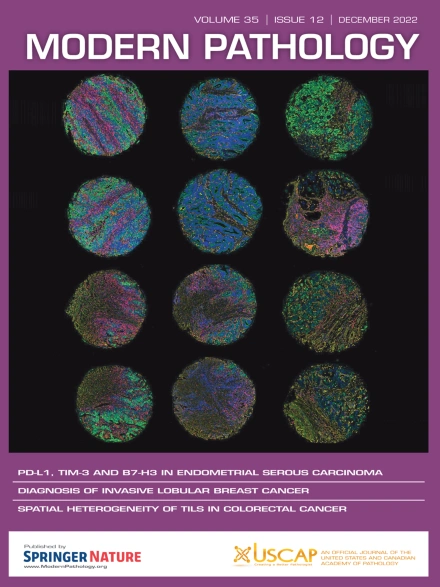泛癌分子生物标志物:外科病理学家的实际考虑。
IF 5.5
1区 医学
Q1 PATHOLOGY
引用次数: 0
摘要
传统的癌症解剖病理分类是基于组织起源和形态和免疫组织化学特征的恶性细胞。随着大规模平行测序或下一代测序(NGS)技术的进步,不同肿瘤类型共享的致癌驱动因素越来越多地被发现并用作泛癌症生物标志物。这种方法反映在越来越多的fda批准的肿瘤不确定疗法中,包括用于微卫星不稳定性和高肿瘤突变负担的派姆单抗,用于NTRK融合实体肿瘤的larorectinib和entrectinib,以及用于BRAF v600e突变肿瘤的dabrafenib-trametinib联合治疗。目前正在研究的其他几种生物标志物包括FGFR、RET和ROS1融合物;ERBB2放大;AKT1/2/3、NF1、RAS通路和MAPK通路的突变。随着分子检测越来越多地纳入常规肿瘤检查,更多泛癌症生物标志物的出现可能更多的是“何时”而不是“是否”的问题。在这篇综述中,我们首先探讨了外科和分子病理学交叉领域的一些概念和技术考虑,然后简要概述了已建立的和新兴的分子泛癌症生物标志物及其诊断和临床应用。本文章由计算机程序翻译,如有差异,请以英文原文为准。
Pan-Cancer Molecular Biomarkers: Practical Considerations for the Surgical Pathologist
Traditional anatomic pathologic classification of cancer is based on tissue of origin and morphologic and immunohistochemical characterization of the malignant cells. With the technological improvements of massively parallel or next-generation sequencing, oncogenic drivers that are shared across different tumor types are increasingly being identified and used as pan-cancer biomarkers. This approach is reflected in the growing list of Food and Drug Administration-approved tumor-agnostic therapies, including pembrolizumab in the setting of microsatellite instability and high tumor mutational burden, larotrectinib and entrectinib for solid tumors with NTRK fusions, and combined dabrafenib-trametinib for BRAF V600E-mutated neoplasms. Several other biomarkers are currently under investigation, including fibroblast growth factor receptor (FGFR), RET, and ROS1 fusions; ERBB2 amplification; and mutations in the AKT1/2/3, NF1, RAS pathway and (mitogen-activated protein kinase (MAPK) pathway. As molecular assays are increasingly incorporated into routine tumor workup, the emergence of additional pan-cancer biomarkers is likely to be a matter more of “when” than “if.” In this review, we first explore some of the conceptual and technical considerations at the intersection of surgical and molecular pathology, followed by a brief overview of both established and emerging molecular pan-cancer biomarkers and their diagnostic and clinical applications.
求助全文
通过发布文献求助,成功后即可免费获取论文全文。
去求助
来源期刊

Modern Pathology
医学-病理学
CiteScore
14.30
自引率
2.70%
发文量
174
审稿时长
18 days
期刊介绍:
Modern Pathology, an international journal under the ownership of The United States & Canadian Academy of Pathology (USCAP), serves as an authoritative platform for publishing top-tier clinical and translational research studies in pathology.
Original manuscripts are the primary focus of Modern Pathology, complemented by impactful editorials, reviews, and practice guidelines covering all facets of precision diagnostics in human pathology. The journal's scope includes advancements in molecular diagnostics and genomic classifications of diseases, breakthroughs in immune-oncology, computational science, applied bioinformatics, and digital pathology.
 求助内容:
求助内容: 应助结果提醒方式:
应助结果提醒方式:


